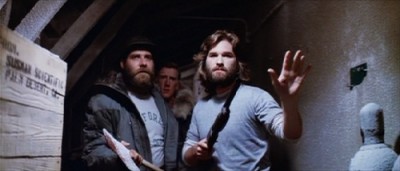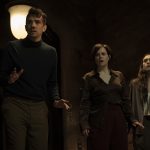(The Brooklyn Academy of Music (BAM) is running a retrospective of John Carpenter films February 5-22, 2015. The lineup is enough to make a tear fall from your eye. Can’t make it? Don’t worry. Hammer to Nail has you covered as our own Evan Louison goes deep on John Carpenter: Master of Fear. Read part one if you haven’t already, and if you have, enjoy part two!)
the terms, set
In Carpenter’s narrative work, there are always the limits to the play, the confines of time or setting, that inform the greater progression of the adventure, or however much “story” figures into the proceedings (it needn’t). It’s the design, the shape, the limit that is put in place first, then the people are lined up and placed within the circumstantial foundation. In Halloween, the conceit is almost transparent—the one night when masks make hiding in plain sight almost too easy, when mischief provides the perfect cover for murder. Without any visible shackles, Curtis’ Laurie Strode is kept in place by the fact that no one will/can help her, because this is that crazy evening where all screams can be discounted, where all cries for help are most likely just “kids” messing around like they do. But the prison is always there in Carpenter’s world—his heroes are always trapped, with the Monster inside with them, forced to find a way out. In The Fog, the eponymous looming danger rolling into Antonio Bay encases the seaside community in a strict perimeter, leaving them nowhere to hide or escape to, forcing them to confront each other and the Evil. In Prince of Darkness, it is the same—brought by a Professor to examine an archaeological find in the basement of an old church, the research team is placed under siege, a legion of zombie streetpeople menacing outside, blocking their escape, keeping them locked in. The amount of times that heroes in Carpenter’s world(s) have less than 24 hours to resolve and conquer some colossus of unstoppable, pending doom, is surely a staggering number. Nearly every time it would seem that the imminent assurance of the End, and not just its proximity, must inspire something of resilience, to get through the night, to see the cold light of day again, the time when the Shadows will be forced to flee. A world where people aren’t people, be they parasitically assimilated and consumed by an alien replicant species (The Thing), or perhaps even Andromedan tourists [read: colonists] (They Live), their presence disguised by radio signals, only visible with special lenses, the traps are often set around the elements of phantasm, but also the concept that sometimes the prison can be a feeling, mistakenly, of being free.
 a curse : the darkness and everything else in it
a curse : the darkness and everything else in it
Freedom from the past is something never given or taken lightly in this world. Carpenter plagues his heroes, his townspeople, he places them under impossible conditions and strain, obstacles in their path seemingly insurmountable. He curses every inhabitant of his world with some hidden, insidious darkness, an ugly spirit, malevolent and powerful, lurking deep in the cracks. At times, the past becomes a structure that is a sounding board for the bitter contempt they hold the rest of the population in, forming their skill set of lessons hard won and learned. Everyone in these narratives, chapters to one story, runs from something, whether a secret or something too heavy to even try and lift up to the light, the weight of it unbearable, inside them. It is Snake Plissken’s revenge upon the whole world, RJ MacReady’s stinging indictment at last leveled at the whole world, and John Nada’s stubborn resistance to submit to the world, that brings them closer to our hearts than any other typical, bravado-soaked walking dynamo could, touching a part of us felt only while engaged fully in their path with them, a part we didn’t know existed, where heroes didn’t come with a suspension of disbelief, or rather, didn’t have to, because they seemed like in spite of all the heroics and unlikely prowess, they might be just like us. Similarly, Carpenter’s Prophets of Doom, Father Malone in The Fog, Pleasance’s Priest in Prince, all seem hunted and stung by some ancient misdeed, if not of their own hand, then someone they feel responsible for. Laurie Strode, followed by her brother, a complete monster, runs from a past she does not even realize is hers, as attached to her as her head, as long as she manages to keep it. In this story, overarchingly it would appear that what the past represents is simply this—a danger that can catch up to you at any time. Your curse may not be yours and yours alone, but pay for it you will still. “We’re all cursed. All of us,” in the words of Father Malone. Suspicion, conspiracy, treachery of coercion, these fears are nothing compared to the unknown in all these shadowplays, and the unknown is the Curse. It is The Shape, personified. The Shape, Himself. He came home.
Destiny plays more into this story than in most of this variety, so many tales of this order conflicted and caught between outright exploitative shock and the idea of chance, how unpredictable encounters with horror that ordinary lives happen upon are taken in turn. For each of these little narratives that make up this big idea, that a hero is born of his elements, of her environment, but also of their destined fate, somewhat predetermined and indeterminate in the same instance, unknowable in either regard, participates on some level in the traditional mythic structure of storytelling so long since exhausted in film, just beginning to finally hear its own slaughterhouse screams, on its last legs as it has been for some time. But they take part in their own, unassuming way, in a way that does not call attention to themselves or to their own artifice, to their own pretensions and narrative blur. Donald Pleasance’s now legendary performance as Loomis seems deathly serious amidst the clueless townsfolk, but that’s quite simply because he is—serious as Death. In Assault, that same receptionist says to her death row comrade Wilson, “I’ve never had much faith in anyone coming to my rescue,” to which he replies, “Maybe you’ve been associating with the wrong people… I believe in one man.” Plissken can rescue the President from a downed Air Force One, because he can, because he’s the only one who can, because it’s in the cards for him to play out the rest of the hand, so he can maybe sit out the next one. Strode manages to subdue and ultimately escape Michael Meyers, because she’s the least likely to be able to defend herself against him. It’s her destiny to confront unimaginable horror, and her fate to surpass it. We accept these truths as they must be accepted —- only reconcilable in our minds’ scrutiny because of a certain, human understanding of the notion of predestined paths and perseverance incarnate, being very possible and real, that we on some level all share. An understanding shared with us by the Master Carpenter who built this very Church, so besieged by ghouls, by the dead risen again and hungry for company, this haunted house designed specifically for us, confined within it, forced to sit through till the end, which seems all too near at every moment. There’s nothing like a man, stalking up a staircase singing “Amazing Grace, how sweet the Sound!” while swinging a chair, only to tear out his own throat and then rise newly resurrected, to shake you, make you grasp one thing about this whole thing : the only way out is run. It looks like hell, but it’s all we’ve got.
Let us go over the details once again: In each of Carpenter’s films, a certain number of aesthetic touches not only appear, but add the same dimension and character to nearly all of his set-pieces, designing a consistent visual world that sprawls across several narratives. To note, specifically Assault on Precinct 13, Halloween, The Fog, Escape from New York, The Thing, Prince of Darkness, They Live. In each of these, the same images make themselves known: An angry mob, reminiscent of a lynching, gathers with torches raised high. Smoke, or the eponymous Fog creeps in, and by this action it is clear the substance itself is embodiment of some living, breathing thing. Religious imagery abound, across several of the films, with churches even becoming the battleground for a final showdown. Actions occur in the background, unbeknownst to the good people in the foreground, often facing the audience, their expressions haunting to us for they show how close Evil could be at hand, to touch, at any time, only moments away. This evil, personified so expressly in Michael Meyers, or as the character is credited in Halloween, The Shape, rises slowly, cocks its blank stare slightly to one side, and breathes through every motion as it moves towards us. Dr. Loomis, who knows too well the danger unleashed through Meyers’ escape and return to Haddonfield, waits for the Sheriff, patiently, as Meyers’ stolen state official plated station wagon drives by behind him. All of it is slow, for true evil has the confidence to take its time. The living dead don’t run at us, they crawl along behind us at Reaper speed, for they know it’s only a matter of time, and fate. Often, it is the distance, dynamically speaking, between the audience and the characters, that helps brings this wrought sense of dread that exists to everything. Characters speak as if they don’t know what’s going on. And in some sense, that’s a part of the structure’s success—we always know more about what’s coming than those caught off guard in the fray, stuck before us on the screen.
All throughout Carpenter’s cinema, music plays an essential, seminal role in forming the all-encapsulating, insular feel of his realities, often beyond dystopian, the crackle of transmissions lost and recorded long ago, be they across video, radio, or diary, these are the echoes of the shadow dwellers. The music illuminates the mystery therein. The scores, composed by someone who unlike his father, did not come from classical training alone, but also from rock and roll, are at their worst still futuristic, and at their best, revelatory. Carpenter’s sound that can only be described as a native element to his unique voice, just as one might associate a Steadicam movement or a wall of crosses with his touch. In every instance, no matter how heavy handed, it is brutalist, ruminative, and propulsive for the experiential process of staying in the picture. Sitting in BAM, watching Assault play out on the big screen for the first time, you might find yourself jumping up and down a little in your seat, comforted by the opening title theme, its familiarity. You might realize for a moment, this was one mind who created all of these, this one big adventure, that you knew so well when you were young. You catch yourself smiling in the dark of the theater, and realize for a moment you’re not alone—there’s hardly a vacant seat in the house. It’s packed. But don’t be afraid, no one sees you. For while the lines didn’t form around the block in these films’ time, they seem to have finally sunk in and worked their magic: Everyone is glued to the screen. Look around. Though they already know, they all still came to see what happens next, again.
— Evan Louison













